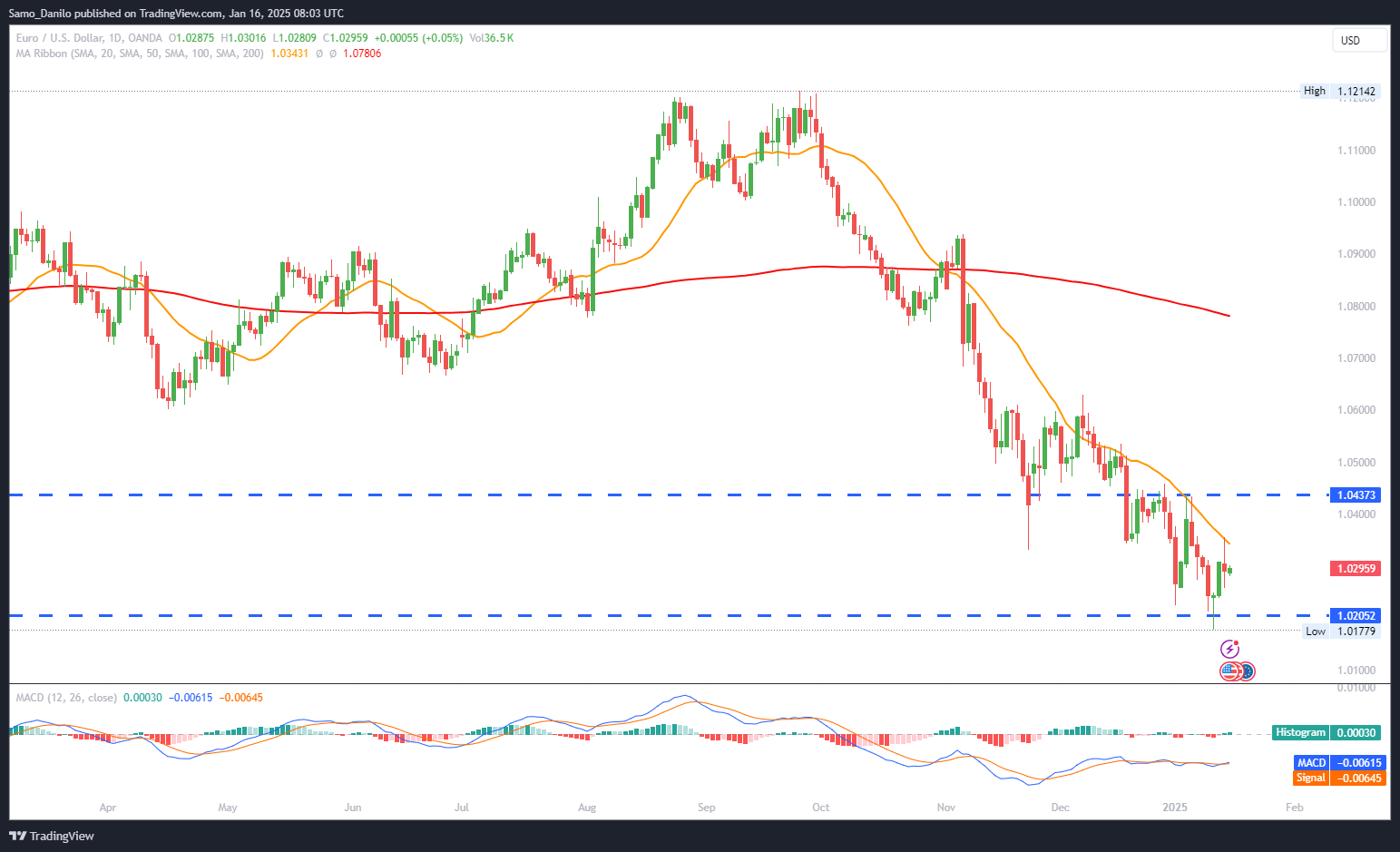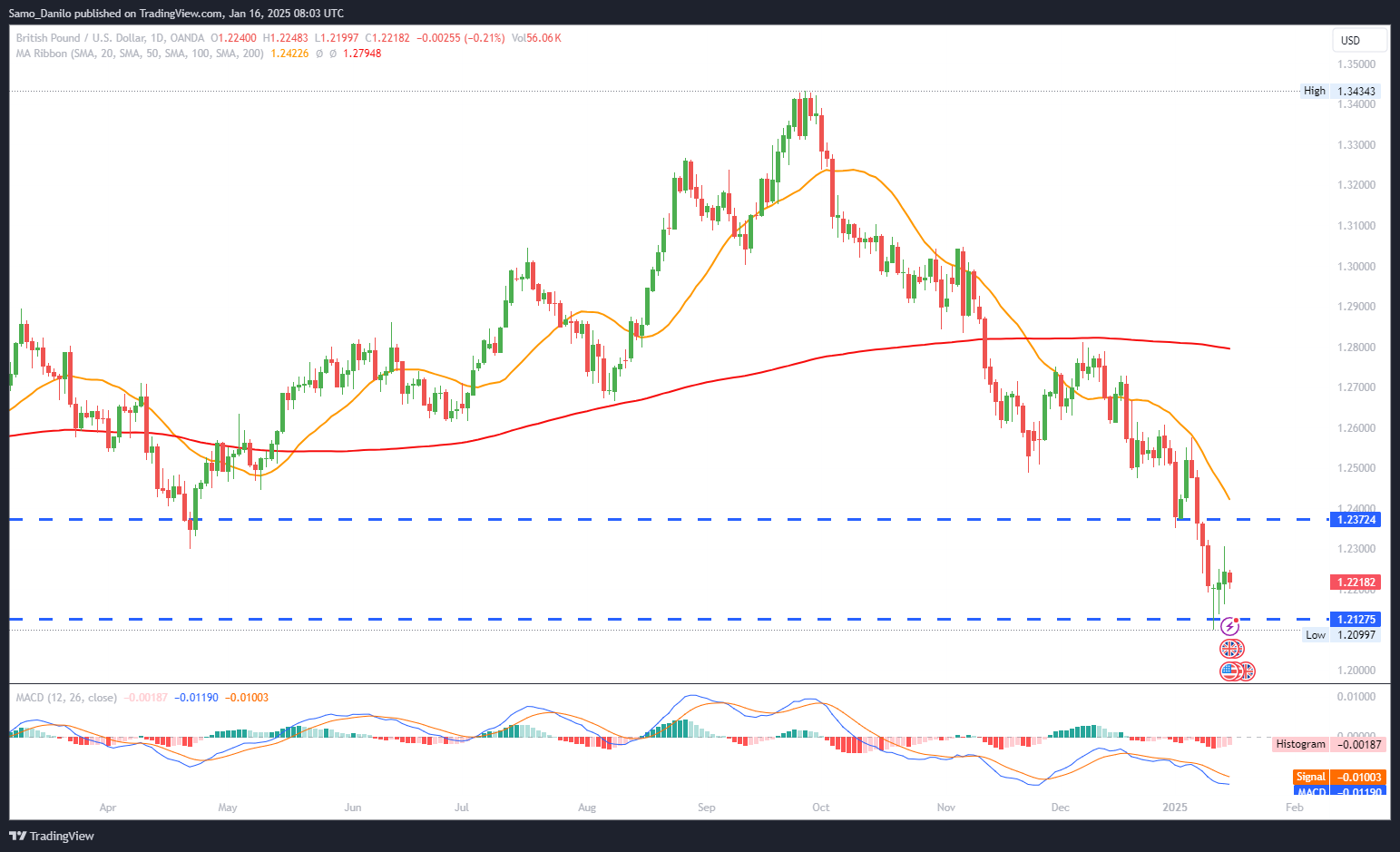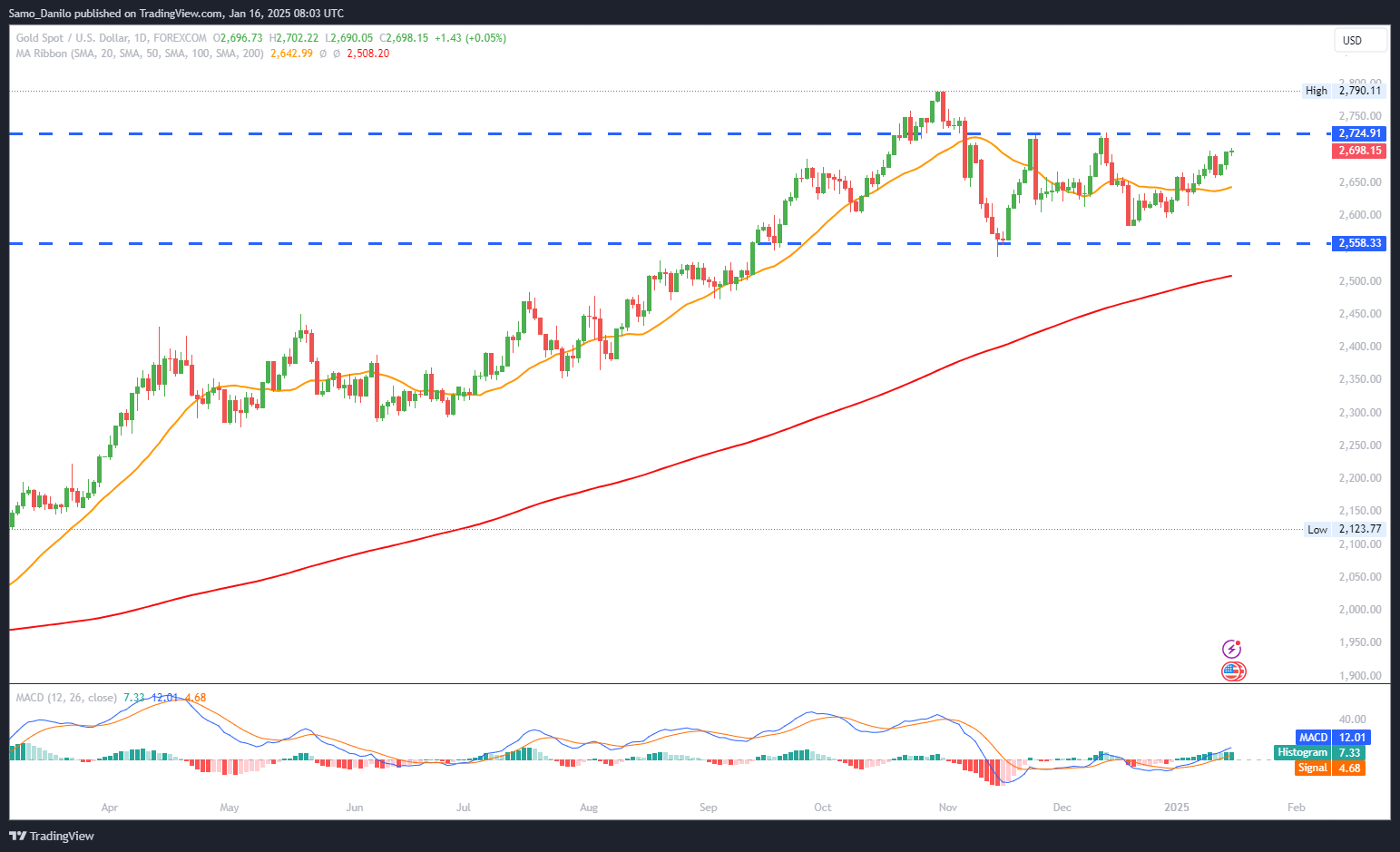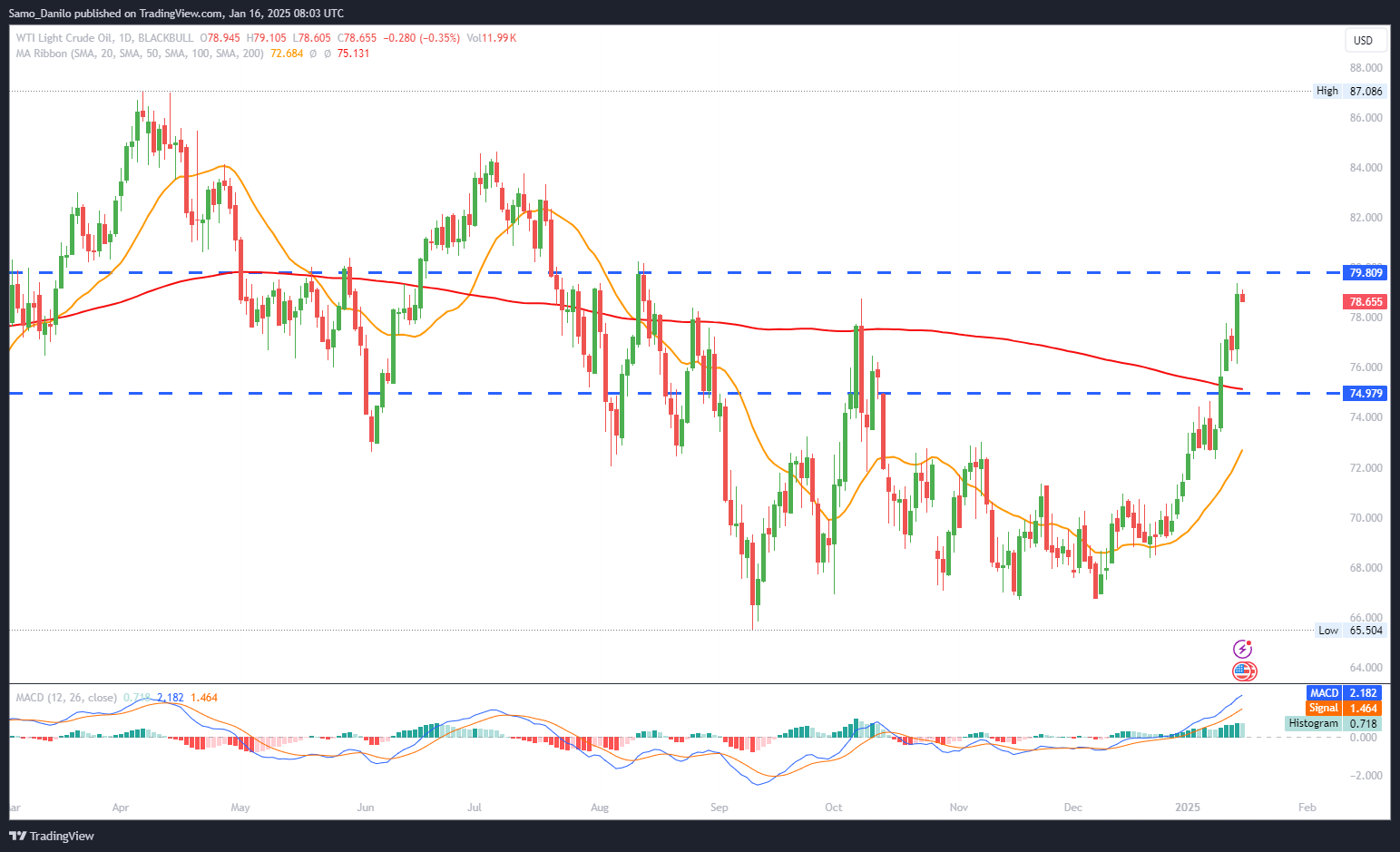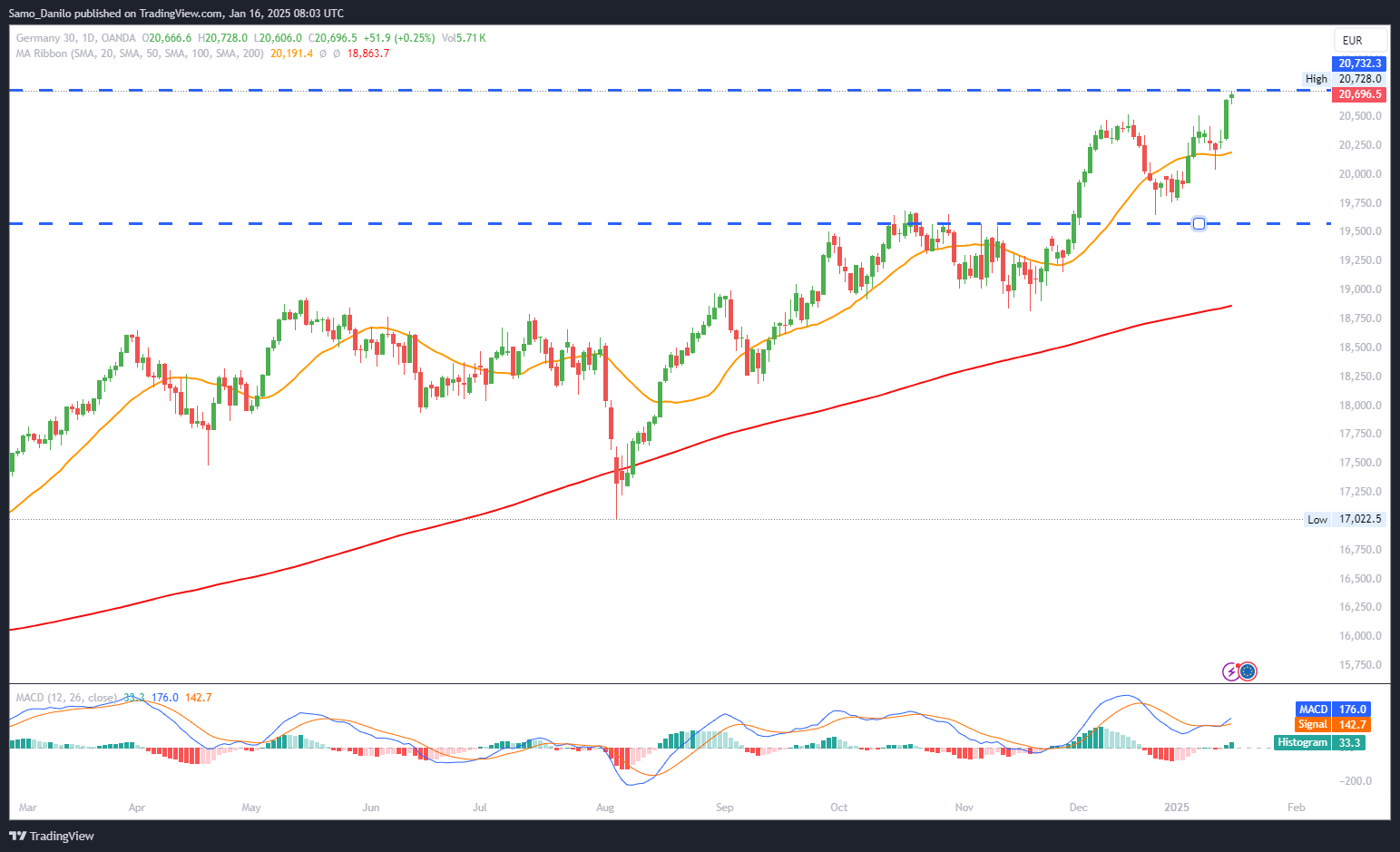EURUSD
- EUR/USD Price: The EUR/USD pair remains subdued under the 1.0300 mark during early European trading hours on Thursday. Weak sentiment around the Euro is driven by concerns over potential interest rate cuts from the European Central Bank (ECB).
- ECB Rate Cut: Rising expectations for further rate reductions from the ECB pose downside risks for the Euro. The prospect of a more accommodative monetary policy stance highlights the challenges facing the Eurozone economy amid soft inflation and sluggish growth.
- Eurozone Data: Investors are awaiting Germany's Harmonized Index of Consumer Prices (HICP) data for December, expected to provide insights into inflation trends in the Eurozone's largest economy. Additionally, the release of the ECB Monetary Policy Meeting Accounts later today will be crucial for understanding the central bank’s outlook.
- US CPI Data: Cooler-than-expected US Consumer Price Index (CPI) inflation for December has raised expectations that the Federal Reserve could implement two rate cuts this year. This dovish shift in Fed policy has weakened the US Dollar, limiting further downside for the EUR/USD pair.
- Key US Data: Market participants will closely monitor the US Retail Sales figures for December and the weekly Initial Jobless Claims, both scheduled for release later on Thursday. These reports will provide additional clues about the health of the US economy and influence USD demand.
Closing statement: The EUR/USD pair faces downward pressure as contrasting monetary policy expectations for the ECB and Fed dominate market sentiment. Key economic releases from both the Eurozone and the US later today will be pivotal in determining the pair’s short-term trajectory.
GBPUSD
- GBP/USD Price: The GBP/USD pair faces renewed selling pressure during Thursday’s European session, trading near the 1.2200 mark. Negative sentiment surrounding the British Pound weighs on the pair despite modest support from a softer US Dollar.
- UK Economy: The UK’s Gross Domestic Product (GDP) expanded by 0.1% in November, rebounding from October’s 0.1% contraction. While the positive GDP figure indicates slight economic resilience, it has done little to offset broader market concerns about the UK’s economic outlook.
- UK Production Data: UK Industrial Production fell by 0.4%, and Manufacturing Production declined by 0.3% in November, both missing market expectations. These disappointing readings amplify concerns about the fragility of the UK’s industrial sector and its broader economic recovery.
- Stagflation Fears: Persistent concerns about the UK’s fiscal challenges and the looming risk of stagflation – characterized by high inflation and sluggish growth – have dampened investor confidence in the British Pound. This macroeconomic backdrop further limits the pair's upside potential.
- US Dollar: The US Dollar (USD) weakened after US core Consumer Price Index (CPI) data for December came in below estimates. This has fueled speculation that the Federal Reserve’s rate-cutting cycle might not be over, providing some temporary relief for GBP/USD’s downside momentum.
Closing statement: GBP/USD remains under pressure amid weak UK economic data and stagflation fears, while a softer US Dollar provides limited support. Traders will closely monitor upcoming economic indicators from both the UK and US for further guidance on the pair’s near-term direction.
XAUUSD
- Gold Price: Gold (XAU/USD) faces resistance near the $2,700 mark, retreating from a one-month high reached earlier on Thursday. The lack of sustained bullish momentum suggests profit-taking or cautious sentiment ahead of upcoming economic data.
- Market Expectations: Following softer-than-expected December inflation figures, markets now anticipate the Federal Reserve to implement 40 basis points (bps) of rate cuts by the end of the year, up from 31 bps previously. This adjustment has created mixed sentiment for Gold prices.
- Fed Official: Richmond Fed President Tom Barkin acknowledged progress toward the central bank’s 2% inflation target but reiterated the need for restrictive interest rates. His comments temper expectations for an aggressive easing cycle, slightly weighing on XAU/USD.
- Geopolitical Updates: Qatar’s Prime Minister announced a ceasefire agreement between Israel and Hamas, which includes an exchange of hostages and prisoners. This development has contributed to easing geopolitical tensions, reducing safe-haven demand for Gold.
- US Data: Traders await key US economic data, including monthly Retail Sales and weekly Initial Jobless Claims, for further direction. These figures could shape expectations for the Fed’s policy trajectory and influence XAU/USD dynamics.
Closing statement: Gold struggles to maintain gains above $2,700 as geopolitical developments and mixed signals on the Fed’s policy path temper momentum. Market participants will focus on US economic releases for clearer guidance on the precious metal’s near-term trajectory.
CRUDE OIL
- WTI Price: West Texas Intermediate (WTI) crude oil is trading around $78.95 on Thursday, holding steady despite fluctuating geopolitical developments. The market remains cautious as traders weigh potential supply disruptions against easing Middle East tensions.
- Geopolitical Risks: Russia's retaliatory strikes on Ukraine, targeting gas and energy infrastructure, have heightened supply risks.
- Middle East Ceasefire: The agreement between Israel and Hamas to cease hostilities and exchange prisoners alleviates immediate concerns about supply disruptions in a key oil-producing region. This development may limit upside momentum for crude oil in the near term.
- US Crude Stockpile: The US Energy Information Administration (EIA) reported a 1.962 million-barrel decline in crude oil stockpiles for the week ending January 10, signaling robust demand and providing underlying support for WTI prices.
- Economic Data: Oil traders are eyeing US economic indicators, including December Retail Sales and weekly Initial Jobless Claims, for cues on economic activity and energy demand. These data points could influence WTI price trends later in the session.
Closing statement: WTI remains supported by declining US stockpiles but faces mixed influences from geopolitical developments and upcoming US economic data. Traders will monitor key indicators and geopolitical headlines for further price direction.
DAX
- DAX Price: The DAX surged to a record high above 20,600 points on Wednesday, closing 1.50% higher at 20,574.68. This rally was driven by positive U.S. consumer price data and robust quarterly earnings reports from U.S. banks, which boosted investor confidence.
- U.S. Inflation Data: December’s U.S. inflation data showed an expected intensification, but the core rate—critical for the Federal Reserve’s monetary policy—unexpectedly declined. This spurred optimism for a more dovish stance by the Fed, supporting risk-on sentiment in global markets.
- Germany’s Inflation: German consumer prices increased by 2.2% year-on-year in 2024, marking a significant decline from the elevated inflation rates of the past three years. This moderation reflects easing price pressures, providing relief to businesses and consumers alike.
- Market Drivers: Market sentiment remains influenced by developments in U.S. trade policy and potential stimulus from China. Fresh measures from Beijing and reduced tariff threats could significantly benefit German exporters, particularly in the industrial and automotive sectors.
- Economic Events: Investors should focus on the Euro Area trade balance figures and U.S. economic indicators, including December Retail Sales and weekly Initial Jobless Claims. These data points are expected to provide additional clarity on economic trends and their implications for the DAX.
Closing statement: The DAX remains well-supported by easing inflation concerns and global market optimism. However, investors should remain vigilant regarding U.S.-China developments and key economic data releases, which could influence sentiment and future price action.
